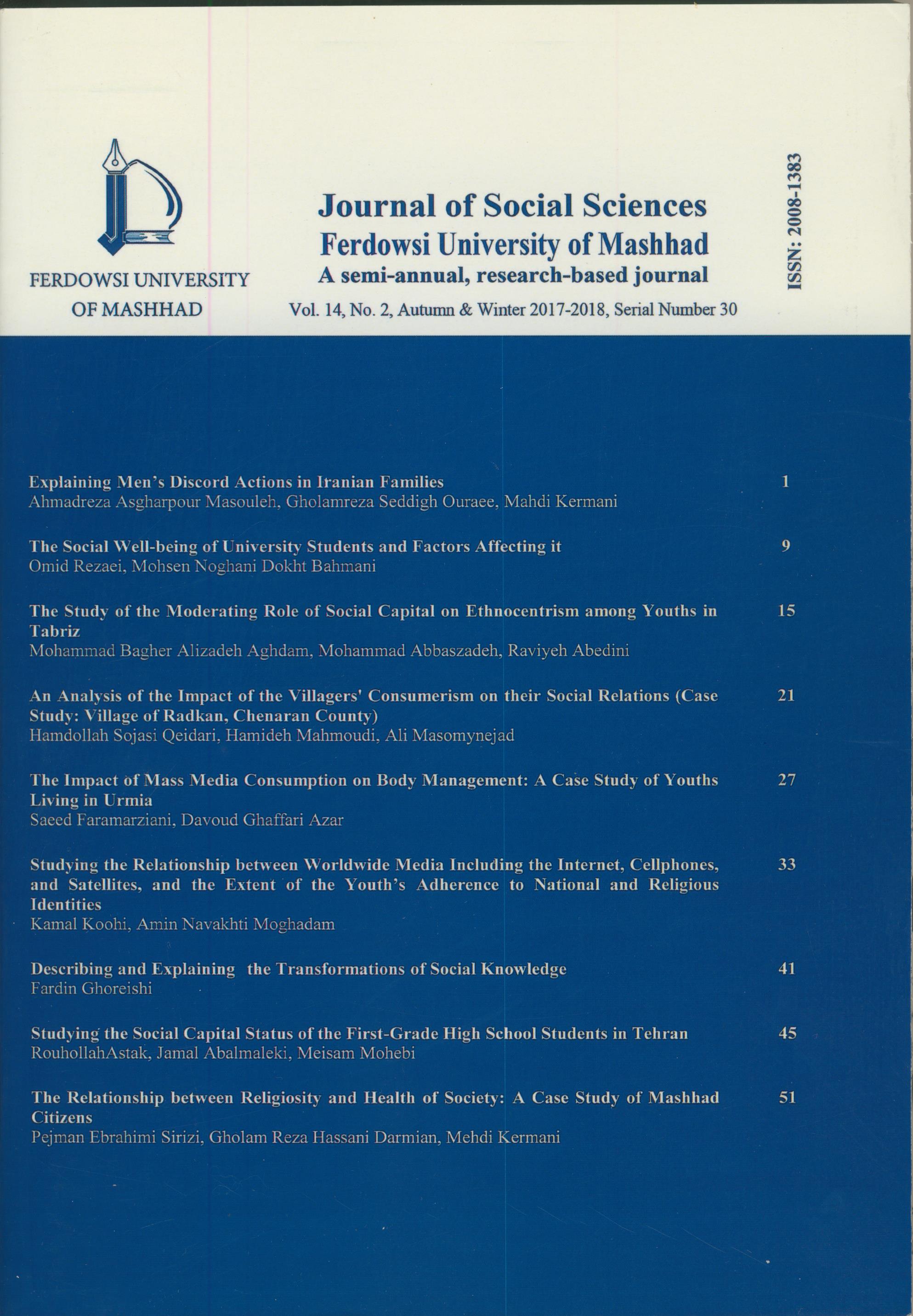Document Type : Scientific-Research
Authors
Ferdowsi University of Mashhad
Abstract
Extended Abstract
1. Introduction
Health is the most fundamental aspect on which human life relies. In addition to informing countries on providing mental, physical, and social health for all members of their societies, the World Health Organization (WHO) asserts that no aspect of health is superior to the other. Furthermore, the growth and success of any society depends on the health of its members. Identifying the determining factors related to the health of societies in line with policy-making and planning at micro and macro levels is considered as the major concerns of any country in terms of physical, mental, and social health (Hezarjaribi & Arfa’ei Einoddin, 2012). Given the various definitions expressed for health, the one offered by WHO is the most acceptable rendering health as a state of complete physical, mental, and social well-being and not merely the absence of disease or infirmity (The World Health Organization, 2005). One of the factors related to citizens’ health is the extent of religiosity. Religion, is a reality that is considerably present in various aspects of human life. As one of the five main identities of any society, religion has found a special place in categories presented by sociologists. Several scientists believe that many health-related variables could be explained through religious beliefs. Religion is, in fact, one of the effective factors on behavior and cognition. Believing in a religion leads to the formation of meaning, hopefulness, feeling of control, healthier lifestyle, and being approved by others, all of which improve one’s health (Pourmohammad, Jahanbakhsh, & Mohammadi, 2017). Researchers in the area of physical and mental health suggest a connection between humans’ spiritual life and their physical and mental well-being (Mousavi & Akbar Zardkhaneh, 2011).
2. Theoretical Framework
There are two different approaches to define health: 1. The disease-centered approach: This approach is limited to the presence and absence of diseases in various physical and mental categories. 2. The health-centered approach: According to this approach health is defined as having high degrees of well-being. One of the scholars in the field of health is Keyes (2006) whose works entail sociological and psychological tips. According to his theory, the possibility of assessing individuals’ quality of life and personal performance without considering social criteria is a question that has been missing from the history of studies on health, particularly mental health. He believes that well-being involves a social foundation and defines individuals’ social health as an assessment of their states and performances in the society. In this regard, proper performance in life is more than having mere physical and mental health, incorporating various social challenges. Another prominent expert who has presented approaches on the relation between health and religiosity is Harold Quing. He regards religion and praying as more than words and physiological responses. His studies clearly show that religious individuals lead healthier lives and experience greater overall happiness; they suffer less from diseases or depression and even if they do, they can be cured faster. Koenig (2007) presented ten mechanisms to explain the relation between religion and mental health, almost all of which confirm the positive impact of religiosity on individuals’ mental and physical health (Riyahi, Aliverdinia, & Baniasad, 2008).
3. Method
In terms of purpose, the present inquiry is an applied study in which data collection was carried out using the survey method. It is also a longitudinal study conducted through multiple time periods. The population of the study included the citizens of Mashhad who were over thirty years old, out of which 300 were selected as the sample population using Cochran’s formula. The standard SF36 questionnaire and Glock and Stark’s religiosity questionnaire were used for data collection. Furthermore, multi-stage cluster sampling was used to indicate sample units.
4. Findings
Among the 300 citizens investigated, 32% were women and 68% were men (M=41.39). The average number of children in the investigated families was 4.15. More than half of the participants (i.e., 51.7%), 35.3% had a part-time job, and13% were unemployed. Considering the types of occupations, 39.3% of the participants had government jobs, while 48.7% were self-employed; moreover, 12% did not specify their occupation. The majority of the participants, (i.e., 79% were married. while 1% were widowed or divorced and 19% were single. The extent of general health for the citizens of Mashhad who were over 30 years old was found to be above average, the highest extent of which belonged to physical (physiological) health. Furthermore, there was a linear relationship between the level of religiosity of the participants and their general health, as the higher the level of individuals’ religiosity, the higher their level of general health would be.
5. Discussion and Conclusion
The present study was conducted to examine the impact of religiosity on the health of citizens aged 30 years or over in Mashhad. The descriptive findings of the study show that the extent of religiosity in the sample population is at a high level (3.953 out of 5). As the Islamic culture is the dominant culture of the society and Mashhad is mainly regarded as a religious city, individuals’ beliefs are supposed to be under the influence of the Islamic culture. Furthermore, the citizens’ health were at a high level (77.176 out of 100).
The inferential findings of the study showed a significant correlation between the independent variable of religiosity and citizens’ (aged 30 years or above) health (r=0.434). Moreover, it was found that the correlation between religiosity and social mental health is greater than the correlation between religiosity and the physical health. The results of the multiple regression analysis demonstrate that the variables introduced to the model, explain almost 36.7% of changes in the citizens’ health. Among the variables introduced to the model, the independent variable of religiosity (in knowledge dimension) had the highest impact on citizens’ health with the standardized coefficient of 0.479.
Keywords

Send comment about this article